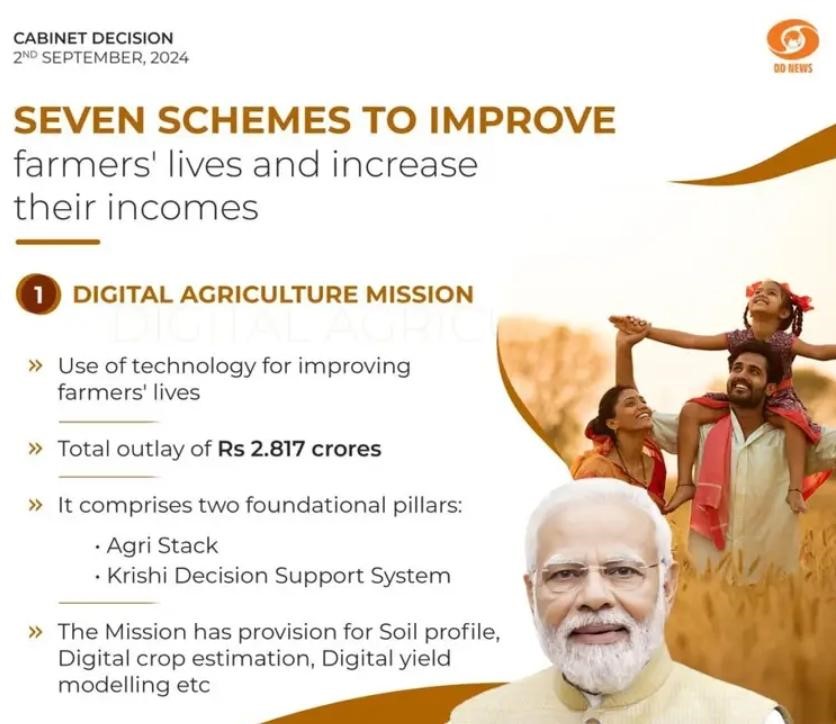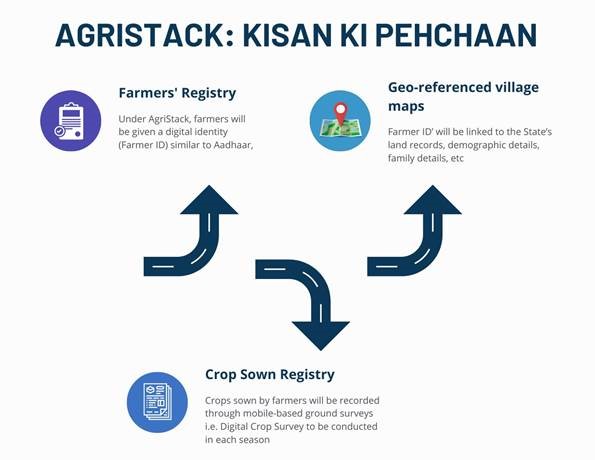5 September 2024 : PIB Summary For UPSC
1. Digital Agriculture Mission: Tech for Transforming Farmers’ Lives
(Source – https://pib.gov.in/PressReleseDetail.aspx?PRID=2051719 )
| Topic: GS3 – Agriculture, GS2 – Governance – Government Policies |
| Context |
|
Digital Agriculture Mission

Approval and Financial Outlay
- Launched by the Union Cabinet on September 2, 2024, with a budget of Rs. 2,817 Crore.
- Central government’s share: Rs. 1,940 Crore.
Objectives
- Transform agriculture through digital technologies.
- Create Digital Public Infrastructure (DPI) and enhance farmer-centric services.
Key Component

- AgriStack:
- Farmers’ Registry: Digital identity for farmers.
- Geo-referenced Village Maps: Detailed mapping of farming areas.
- Crop Sown Registry: Record of crops sown by farmers.
- Farmer ID: A digital ID akin to Aadhaar, linking various farmer-related data.
- Krishi Decision Support System (DSS):
- Integrates remote sensing data on crops, soil, weather, and water resources.
- Soil Profile Mapping:
- Mapping soil profiles at a 1:10,000 scale for 142 million hectares; 29 million hectares mapped so far.
- Digital General Crop Estimation Survey (DGCES):
- Provides precise yield estimates through crop-cutting experiments.
Implementation
- AgriStack Pilot Projects: Conducted in six states: Uttar Pradesh, Gujarat, Maharashtra, Haryana, Punjab, and Tamil Nadu.
- Targets:
- Create digital IDs for 11 crore farmers over three years.
- Nationwide Digital Crop Survey covering all districts by 2025-26.
Benefits
- Reduces paperwork and physical visits for accessing services.
- Enhances efficiency and transparency in government schemes and loan systems.
- Improves disaster response and insurance claims through accurate crop mapping.
- Provides tailored advisory services for crop management and irrigation.
Impact
- Aims to revolutionise service delivery, increase productivity, and enhance sustainability in Indian agriculture.
| PYQ: How does e-Technology help farmers in production and marketing of agricultural produce? Explain it. (150 words/10m) (UPSC CSE (M) GS-3 2023) |
| Practice Question: Evaluate the potential impact of the ‘Digital Agriculture Mission’ on India’s agricultural sector. Analyse how digitalization could address challenges in agriculture and improve service delivery for farmers. (250 Words /15 marks) |
2. Government launches Vishvasya-Blockchain Technology Stack; To offer Blockchain-as-a-Service with a geographically distributed infrastructure
(Source – https://pib.gov.in/PressReleseDetail.aspx?PRID=2051934 )
| Context |
|
Vishvasya – Blockchain Technology Stack:
- Vishvasya is a Blockchain-as-a-Service (BaaS) platform developed by the Ministry of Electronics and Information Technology (MeitY).
- It provides a secure, permissioned blockchain infrastructure that supports various citizen-centric applications.
- Hosted across geographically distributed data centres, Vishvasya is designed to enhance transparency, security, and trust in digital services by enabling decentralised applications on a reliable blockchain framework.
- It offers features like smart contracts, API gateways, and privacy protections to ensure the safe execution of blockchain-based solutions.
Potential Applications of Vishvasya – Blockchain Technology Stack:
- Citizen Services: Secure digital identities, verification processes, and tamper-proof records for public services such as land registries, healthcare, and education.
- Financial Services: Streamlined, secure transactions for banking, insurance, and financial operations, reducing fraud and enhancing transparency.
- Supply Chain Management: Traceability and verification for goods, ensuring authenticity and accountability in agriculture, pharmaceuticals, and logistics sectors.
- Governance: Transparent and accountable e-governance services, including voting systems and public policy execution.
- Legal Applications: Smart contracts for automating legal agreements, ensuring enforcement and reducing disputes.
- Academic and Research Collaboration: Platforms for educational institutions and startups to prototype blockchain applications and conduct research securely.
| Blockchain Technology |
|
|
PYQ: Q. With reference to “Blockchain Technology”, consider the following statements: (2020) It is a public ledger that everyone can inspect, but which no single user controls. The structure and design of the blockchain is such that all the data in it are about cryptocurrency only. Applications that depend on basic features of blockchain can be developed without anybody’s permission. Which of the statements given above is/are correct? (a) 1 only Ans: Option D |
| Practice Question: Discuss the potential of blockchain technology in transforming governance, financial systems, and data management in India. Highlight the challenges associated with its implementation. (150 Words /10 marks) |
